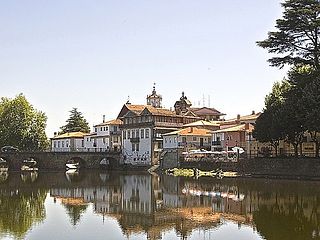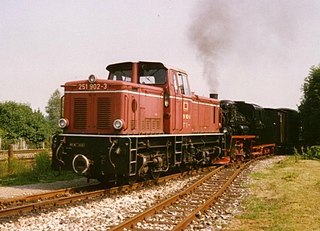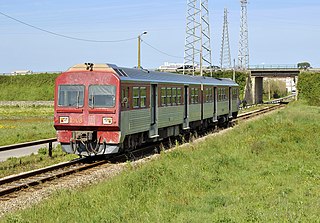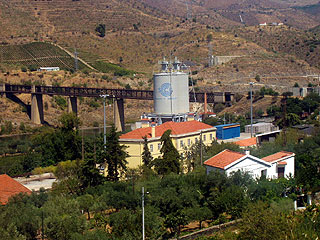
The Tâmega or Támega is a river in Galicia, Spain and Portugal. It begins its course near Verín, Galicia, Spain, and flows to Portugal in the provinces of Trás-os-Montes and Douro Litoral.

Linha do Vouga(the Vouga line) is the last surviving metre gauge railway line in Portugal still operated by Comboios de Portugal. The other remaining metre gauge lines all closed in 2009. The line is, however, also under the threat of closure.

The DB Class V 51 and DB Class V 52 are classes of almost identical narrow gauge 4 axle diesel hydraulic locomotives built in 1964 for the Deutsche Bundesbahn, being built for 750 mm and 1,000 mm gauge lines respectively.

The Série 0100 are a type of single carriage diesel railcar built for Portuguese Railways (CP). They were built by NOHAB of Trollhättan in Sweden in 1948. They were extensively refurbished in 1980. As of 2012 only six units are still in Portugal; the other six were sold to Argentina and the rest were destroyed by fire or accidents. As of 2013 none are in service in Portugal.

The Tua line was a metre gauge railway line in northern Portugal, which connected Tua to Bragança. The line was opened in 1887 and closed in 2018. The section from Mirandela to Brunheda is planned to be reopened in 2019.

The Corgo line(Linha do Corgo) was a 1,000 mmmetre gauge railway line in northern Portugal. It closed in 2009. It ran north from Régua to Vila Real and Chaves. The line was latterly operated by Comboios de Portugal.

Linha de Guimarães is a railway in Portugal operated by Comboios de Portugal. It runs between Oporto (Porto) and Guimarães; until 1986 it extended eastwards to Fafe. It was extensively modernised in the 2000s, including conversion from metre gauge to Iberian gauge track and electrification.

The Série 9300 were a class of 10 self-propelled diesel railcars built for the metre gauge lines of the Portuguese Railways (CP). They were built by Allan of Rotterdam in 1954; they are similar to the Iberian gauge Série 0300 railcars built by the same manufacturer.

Portugal formerly had several hundred kilometres of narrow-gauge railways, but by 2010 only two lines were still in operation – the Vouga line and the Metro de Mirandela. The lines were operated by Comboios de Portugal and maintained by REFER.

The Série 9700 were a type of diesel multiple unit train used by the Portuguese Railways (CP) on metre gauge lines, including the Tua line and Corgo line. They were originally built by Đuro Đaković in the 1960s for use on 760 mm gauge railways in former Yugoslavia. They were purchased secondhand by CP from the Yugoslav Railways in 1980; for use in Portugal they had to be regauged.

The Série 9630 are a class of diesel multiple unit trains built for the metre gauge lines of Portuguese Railways (CP) in the Porto area. The trains were built in Portugal by Sorefame and entered service in 1991.

Linha do Douro is a railway in northern Portugal. For much of its route the line runs close to the Douro River, offering very scenic views of the river and valley. Trains on the line are operated by Comboios de Portugal (CP).

The Série 9500 are a class of lightweight diesel railcars formerly used by Comboios de Portugal on the metre gauge railways in northern Portugal. They are also known as LRV2000.

The Barca d'Alva–La Fuente de San Esteban railway is a closed Iberian gauge line which connected Barca d'Alva on the Linha do Douro, in northeastern Portugal, to the Spanish railway network. Passenger and cargo trains ran from Porto to Salamanca until its closure in 1985.

Ramal de Aveiro is a Portuguese metre gauge railway line operated by Comboios de Portugal. It connects Aveiro and Sernada, where it connects with Linha do Vouga.

























